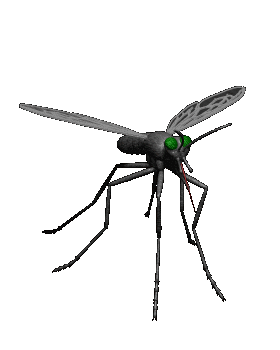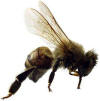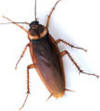Discover Florida Nature
It's time to explore the natural Florida


|
|
|
|
|
 Mosquitoes-
The word "mosquito" is Spanish for "little fly" and they belong to the
order of Diptera – true flies. Mosquitoes are like flies in that they
have two wings, but unlike flies, their wings have scales, their legs
are long, and the females have a long mouth part for piercing skin.
There are many species of mosquitoes that frequent your Florida outdoor
activities, but all require water to breed. Mosquitoes carry diseases
such as encephalitis, malaria, and West Nile Virus, and cause
heartworms in your dog. Mosquitoes-
The word "mosquito" is Spanish for "little fly" and they belong to the
order of Diptera – true flies. Mosquitoes are like flies in that they
have two wings, but unlike flies, their wings have scales, their legs
are long, and the females have a long mouth part for piercing skin.
There are many species of mosquitoes that frequent your Florida outdoor
activities, but all require water to breed. Mosquitoes carry diseases
such as encephalitis, malaria, and West Nile Virus, and cause
heartworms in your dog.  Noseeums-
Also known as "sand fleas," noseeums can make a morning or late
afternoon at the beach unbearable, especially in the summer and early
fall. Sand fleas are actually a gnat (Culicoides furens) that are
sensitive to temperature and humidity. Noseeums are nearly invisible and
Floridians spell it No-See-Ums! The noseeums bite or sting really isn't
a bite or sting, instead it is the sensation you feel when the acid in
their bodily fluid hits the skin. Noseeums-
Also known as "sand fleas," noseeums can make a morning or late
afternoon at the beach unbearable, especially in the summer and early
fall. Sand fleas are actually a gnat (Culicoides furens) that are
sensitive to temperature and humidity. Noseeums are nearly invisible and
Floridians spell it No-See-Ums! The noseeums bite or sting really isn't
a bite or sting, instead it is the sensation you feel when the acid in
their bodily fluid hits the skin.  Bees-Bees
are often confused with wasps. Although closely related, they differ in
many ways. Bees feed pollen and nectar to their young. They are
beneficial insects that pollinate fruits, vegetables and many other
plants. The most common bees are the honey bee, bumble bee, and
carpenter bee. Bees are not commonly serious problems and usually
require no control. When stung by a honey bee, scrape the bee's stinger
out of the wound immediately. Be careful not to pull it out. If you do,
you will force poison into the wound. If the stinger is not removed, the
poison gland attached to the stinger will continue to pump poison into
the wound for several minutes. Wasps and other bees do not leave a
stinger and are capable of stinging many times. At certain times of the
year (spring and early summer), honey bee colonies divide by swarming.
Swarms are not usually a problem unless they land in an inconvenient
spot or enter a building. Bees-Bees
are often confused with wasps. Although closely related, they differ in
many ways. Bees feed pollen and nectar to their young. They are
beneficial insects that pollinate fruits, vegetables and many other
plants. The most common bees are the honey bee, bumble bee, and
carpenter bee. Bees are not commonly serious problems and usually
require no control. When stung by a honey bee, scrape the bee's stinger
out of the wound immediately. Be careful not to pull it out. If you do,
you will force poison into the wound. If the stinger is not removed, the
poison gland attached to the stinger will continue to pump poison into
the wound for several minutes. Wasps and other bees do not leave a
stinger and are capable of stinging many times. At certain times of the
year (spring and early summer), honey bee colonies divide by swarming.
Swarms are not usually a problem unless they land in an inconvenient
spot or enter a building. Mud
Daubers- Mud daubers are solitary wasps. Each female constructs
a clump of mud cells. There is no worker caste. In the spring, young
adults come out of their nests and mate. The female then build mud-cell
nests. After she completes the nest she captures about 20 spiders,
paralyzing each with her sting as she catches it. Spiders are stored in
the cell and she lays an egg on one of the spiders and caps the cell
with clay. This is repeated until she has built one nest containing 6 to
20 cells. She may then build other nests in other locations. Once a nest
is finished, she leaves it and never returns. The larvae hatch from the
eggs and feed on the paralyzed spiders. Complete development takes place
in the cell. One to three generations can develop in a year. When a wasp
stings it injects a venomous fluid under the skin. The venom causes a
painful swelling that may last several days. In some cases a wasp sting
may cause severe illness or even death. Mud
Daubers- Mud daubers are solitary wasps. Each female constructs
a clump of mud cells. There is no worker caste. In the spring, young
adults come out of their nests and mate. The female then build mud-cell
nests. After she completes the nest she captures about 20 spiders,
paralyzing each with her sting as she catches it. Spiders are stored in
the cell and she lays an egg on one of the spiders and caps the cell
with clay. This is repeated until she has built one nest containing 6 to
20 cells. She may then build other nests in other locations. Once a nest
is finished, she leaves it and never returns. The larvae hatch from the
eggs and feed on the paralyzed spiders. Complete development takes place
in the cell. One to three generations can develop in a year. When a wasp
stings it injects a venomous fluid under the skin. The venom causes a
painful swelling that may last several days. In some cases a wasp sting
may cause severe illness or even death. Ladybugs-
Ladybugs (also called lady birds and lady beetles) are small,
oval-shaped winged insects. These shiny insects are usually red with
black spots or black with red spots on the wing covers. The number of
spots identifies the type of ladybug. Most ladybugs are less than 1/4
inch (4-8 mm) long. As ladybugs age, the color of the spots fade. Birds
are the major predator of the ladybug. Ladybugs will play dead when
threatened. These tiny predators are usually very welcome in gardens
because ladybug larvae and adults eat aphids, mealybugs, and mites
(which are garden pests). Ladybug larvae can eat about 25 aphids a day;
adults can eat over 50. Ladybugs-
Ladybugs (also called lady birds and lady beetles) are small,
oval-shaped winged insects. These shiny insects are usually red with
black spots or black with red spots on the wing covers. The number of
spots identifies the type of ladybug. Most ladybugs are less than 1/4
inch (4-8 mm) long. As ladybugs age, the color of the spots fade. Birds
are the major predator of the ladybug. Ladybugs will play dead when
threatened. These tiny predators are usually very welcome in gardens
because ladybug larvae and adults eat aphids, mealybugs, and mites
(which are garden pests). Ladybug larvae can eat about 25 aphids a day;
adults can eat over 50.  Dragonfly-
The order Odonata contains the dragonflies and damselflies and is one of
the most popular insect groups. There are six families of dragonflies
found in Florida, each of which is easily identifiable. Dragonflies
haven't changed much over the last 300 million years. Today they are one
of the most easily recognized of all insects. The common green darner is
the largest, most abundant and widespread dragonfly species in North
America. Common green darners are called "mosquito hawks" because they
eat mosquitoes, providing an important service to humans. These
dragonflies are commonly found around ponds and open bodies of fresh
water and large blacktop parking lots. When fully grown, green darners
are about 3 inches long and have a wingspan of 4.5 inches. They have a
green head and thorax. The abdomen is yellow and brown on females; long,
slender and bluish on males. Common Green Darners have large compound
eyes, strong jaws, and spiny legs. Their wings are clear with a
yellowish tint toward the tips and are strongly veined with net-like
pattern. Dragonfly-
The order Odonata contains the dragonflies and damselflies and is one of
the most popular insect groups. There are six families of dragonflies
found in Florida, each of which is easily identifiable. Dragonflies
haven't changed much over the last 300 million years. Today they are one
of the most easily recognized of all insects. The common green darner is
the largest, most abundant and widespread dragonfly species in North
America. Common green darners are called "mosquito hawks" because they
eat mosquitoes, providing an important service to humans. These
dragonflies are commonly found around ponds and open bodies of fresh
water and large blacktop parking lots. When fully grown, green darners
are about 3 inches long and have a wingspan of 4.5 inches. They have a
green head and thorax. The abdomen is yellow and brown on females; long,
slender and bluish on males. Common Green Darners have large compound
eyes, strong jaws, and spiny legs. Their wings are clear with a
yellowish tint toward the tips and are strongly veined with net-like
pattern.  Flying
Palmetto Bug- Palmetto bugs are reddish brown and grow up to
two inches in length. It is also known as the American cockroach. It has
a pair of large wings on its back that can be used for flying, but wings
that are tough enough to act like a shield when the cockroach is on the
ground. Palmetto bugs need moisture to survive and only live in warm,
tropical climates. It can be found outdoors across the southern United
States. The Palmetto bug is omnivorous, and will eat almost anything. It
prefers sweets and has been observed eating paper, boots, hair, bread,
fruit, and other dead insects. Palmetto bugs can travel quickly, often
darting out of sight when someone enters a room, and they can fit into
small cracks and under doors despite its fairly large size. It is
considered one of the fastest running insects. Flying
Palmetto Bug- Palmetto bugs are reddish brown and grow up to
two inches in length. It is also known as the American cockroach. It has
a pair of large wings on its back that can be used for flying, but wings
that are tough enough to act like a shield when the cockroach is on the
ground. Palmetto bugs need moisture to survive and only live in warm,
tropical climates. It can be found outdoors across the southern United
States. The Palmetto bug is omnivorous, and will eat almost anything. It
prefers sweets and has been observed eating paper, boots, hair, bread,
fruit, and other dead insects. Palmetto bugs can travel quickly, often
darting out of sight when someone enters a room, and they can fit into
small cracks and under doors despite its fairly large size. It is
considered one of the fastest running insects. |
|
|
Advertise | Privacy Statement | Dog Encyclopedia | Video |Contact | Alaska Nature |
|